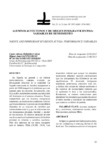Mostrar el registro sencillo del ítem
Alumnos autóctonos y de origen inmigrante en Pisa: variables de rendimiento
| dc.contributor.author | Pereira Casal, Carlos Alberto | es_ES |
| dc.contributor.author | Santos Rego, Miguel Anxo | es_ES |
| dc.contributor.author | Lorenzo Moledo, María del Mar | es_ES |
| dc.date.accessioned | 2014-09-23T12:37:44Z | |
| dc.date.available | 2014-09-23T12:37:44Z | |
| dc.date.issued | 2013 | es_ES |
| dc.identifier.citation | Revista Galego-Portuguesa de Psicoloxía e Educación, 2013, 21: 95-109. ISSN: 1138-1663 | es_ES |
| dc.identifier.issn | 1138-1663 | es_ES |
| dc.identifier.uri | http://hdl.handle.net/2183/12608 | |
| dc.description.abstract | [Resumen] En España en general y en Galicia particularmente, estamos viviendo un preocupante descenso de la natalidad. La llegada continuada de familias inmigrantes a partir del 2000 maquilló el problema que esto suponía para las escuelas. Actualmente, este flujo sufrió un parón provocando una reducción del fenómeno en el sistema educativo. Parece comprobado que los alumnos inmigrantes mantienen un rendimiento académico inferior que los autóctonos. Los motivos de este déficit dependen de un conjunto de variables que interaccionan entre sí, y que se relacionan con las dimensiones personal, familiar y escolar de los alumnos. El objetivo principal de este estudio es analizar los determinantes del ámbito personal en relación a variables escolares. Para ello partimos de los datos recogidos para el Informe PISA (OCDE, 2010). Los resultados indican que aunque los alumnos autóctonos obtienen mejores calificaciones que los inmigrantes, las diferencias no son significativas. El alumnado inmigrante manifiesta preferencia, considera más útil, y dedica más tiempo de trabajo autónomo a las materias de humanidades mientras que el autóctono lo hace a las instrumentales. Finalmente, se extraen conclusiones para identificar los elementos que puedan favorecer el éxito escolar y minimizar las condiciones que acarreen un déficit de partida. | es_ES |
| dc.description.abstract | [Abstract] In Spain in general and Galicia particularly, we are undergoing a worrying decline in the birth rate. The continuous arrival of immigrant families from 2000 on makeup the problem this posed to schools. Currently, this flow suffered a slowdown phenomenon causing a reduction in the education system. It seems proven that immigrant students maintain a lower academic performance than locals. The reasons for this deficit depend on a set of variables that interact with each other, and that relate to the dimensions personal, family and school students. The main objective of this study is to analyze the determinants of the field staff regarding school variables. To do this we start from the data collected for the PISA (OECD, 2010). The results indicate that although students get better grades indigenous immigrants, the differences are not significant. The clear preference immigrant students, considered more useful, and more time devoted to self-employment humanities subjects while native makes the instrumental. Finally, conclusions are drawn to identify the elements that can encourage school success and minimize the conditions that result in a starting deficit | es_ES |
| dc.language.iso | spa | es_ES |
| dc.publisher | Universidade da Coruña | es_ES |
| dc.subject | Alumnos inmigrantes y autóctonos | es_ES |
| dc.subject | Rendimiento escolar | es_ES |
| dc.subject | Variables escolares | es_ES |
| dc.subject | Informe PISA | es_ES |
| dc.subject | Immigrant and native sudents | es_ES |
| dc.subject | School performance | es_ES |
| dc.subject | School variables | es_ES |
| dc.subject | PISA report | es_ES |
| dc.title | Alumnos autóctonos y de origen inmigrante en Pisa: variables de rendimiento | es_ES |
| dc.title.alternative | Native and Immigrant Students at PISA: Performance Variables | es_ES |
| dc.type | journal article | es_ES |
| dc.rights.accessRights | open access | es_ES |






